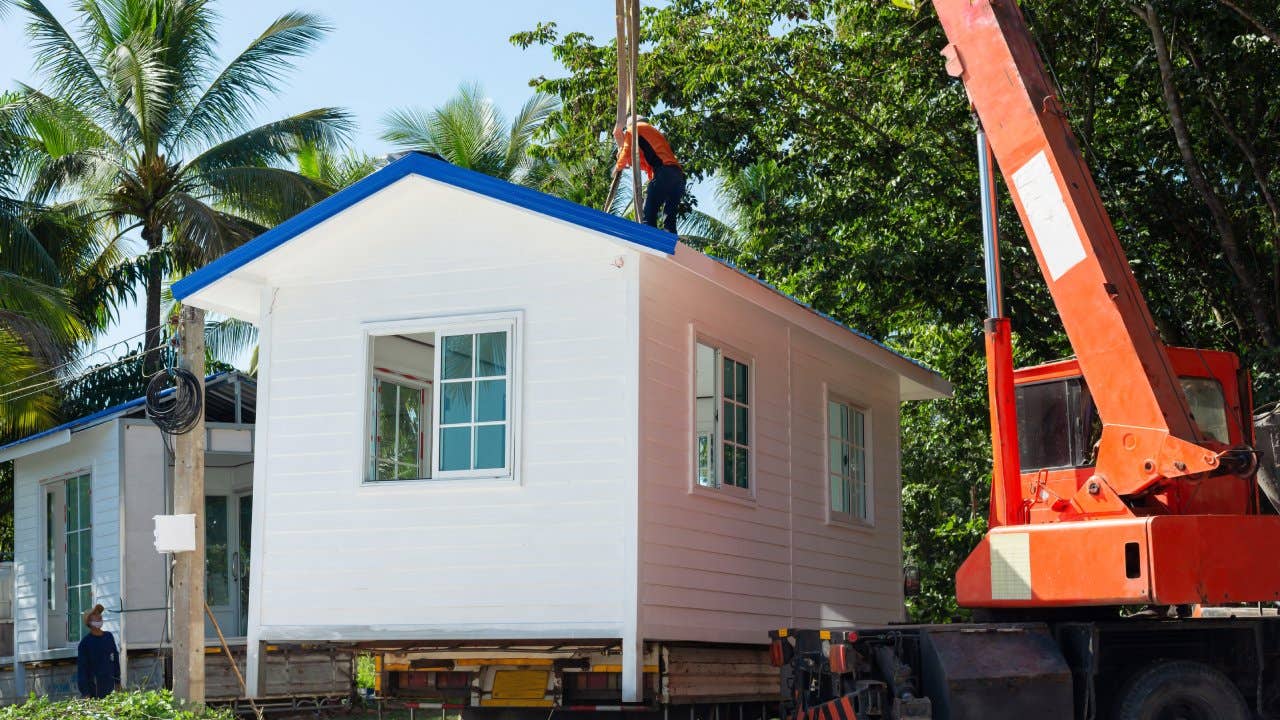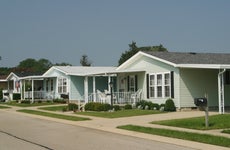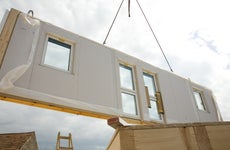Modular vs manufactured homes: What’s the difference?

The Bankrate promise
At Bankrate we strive to help you make smarter financial decisions. While we adhere to strict , this post may contain references to products from our partners. Here's an explanation for .
Many people love the idea of building their dream home, especially given the persistent shortage in housing inventory. But it’s an expensive endeavor. The average price of a new-construction house in January 2022 was nearly $500,000, according to the U.S. Census Bureau.
Luckily, there are plenty of options open to you in the new-build world. Instead of constructing a home from scratch, you might consider buying a prefabricated home, along with a piece of land for it to sit on. Prefabricated homes come in two main types: modular and manufactured.
The distinctions between these two types can be subtle. Let’s delve into the key differences between modular and manufactured homes, and help you determine which variety is right for you.
Modular vs manufactured homes
Like all prefabs, modular and manufactured types of homes share one key characteristic: They are built in a factory, and then moved to the lot where they’ll reside — as opposed to the old-fashioned way of erecting a residence on-site, from the ground up.
What is a modular home?
A traditional stick-built home is constructed of customized parts on a designated site: a foundation is dug and a frame goes up; then walls and a roof are built around it, and the interior is fleshed in with more walls, ceilings and floors. In contrast, modular homes’ components are built off-site, often as a number of discrete units (known as modules). They are then shipped to a site that you own or rent, set on a foundation, and hooked up to local utilities — electrical lines, gas lines, sewage pipes, etc.
The fact that their parts are prefab doesn’t mean you can’t be creative with the design of your home. By connecting together a number of modules, you can customize your home’s design almost as much as if you were building it from scratch.
To construct a modular home, you’ll need to rent or own a piece of land that allows this type of house (not every neighborhood does, so check beforehand with the HOA or local zoning authority). While the basic cost of a modular home runs around $40-80 per square foot, the all-in cost (with installation) of a modular home is $100 to $200 per square foot, or $180,000 to $360,000 for an 1,800-square-foot home. In addition, you’ll need to connect the house to utilities, which can cost anywhere between $3,000 and $20,000.
Pros of modular homes
- Shorter construction time: Since modular homes are made in a factory and assembled on-site relatively quickly, there is less chance of weather-related or supply-chain delays.
- Flexible specs: While you choose from pre-design modules, they do have a good amount of variety in terms of style, material, layout and size. You have a lot of latitude in mixing and matching.
- Reduced waste: Modular homes generally use less energy and produce less waste than stick-built homes.
- Potentially better construction: Production facilities for modular homes are subject to federal quality controls and standards.
Cons of modular homes
- Customization limitations: While you can create a home to your liking, you do have to work within the limitations of within the range of modules that the manufacturer can produce.
- Additional costs: Electrical, plumbing and ductwork aren’t typically part of the base modular home pricing, so you’ll have to pay to have this work done. You’ll also have to shell out extra for the foundation.
- Preconceived prejudices: Some people believe modular homes aren’t as well-constructed or sturdy as traditional builds, which might retard a home’s appreciation and make it more difficult to sell in the future.
What is a manufactured home?
As their name suggests, manufactured homes are made in factories, just like modular homes. They’re built on a steel chassis, like an automobile, and then transported in one piece to a site. However, there is a key difference: While modular homes are permanently attached to a foundation, manufactured homes can be uprooted and moved again.
Because of this, manufactured homes are often associated with temporary housing and trailer homes — in fact, they used to be called “mobile homes.” Today, however, many manufactured homes are not meant to be mobile. While they can be towed to a plot of land, they are often then set up on concrete blocks or metal piers.
In fact, a modern manufactured home can have many of the hallmarks of a traditional home build, including lumber framing, fiberglass insulation, PVC plumbing, drywalls and wood flooring. Homeowners can choose between multiple floor plans and select everything from countertops to tile based on their preferences. Some 22 million Americans live in manufactured homes, according to the Manufactured Housing Institute’s “2021 Industry Overview.”
Manufactured homes are less expensive than traditional homes. According to HomeAdvisor, their total cost is around $100-200 per square foot. In contrast, a traditional new-build home averages $150 per square foot, and can easily go as high as $400.
Some people buy a plot of land for their manufactured home to sit on; others rent a space in a manufactured home park instead.
Pros of manufactured homes
- Affordability: Manufactured homes cost at least half the price of comparable traditional new homes.
- Speed: Manufactured homes take less time to construct.
- Easy to maintain: The home is often under a manufacturer-offered warranty, and the standardized parts can often be quickly replaced.
Cons of Manufactured Homes
- Less equity: Manufactured homes are more likely to depreciate over time than a traditional build, so you won’t build equity. They may not be great for buyers who want to move in a few years.
- Financing: You will find fewer loan options for most manufactured homes. They are considered personal property, not real property, and often you can’t use a conventional mortgage for them.
- Cookie-cutter: While design options do exist, manufactured homes are harder to personalize — or update later on.
- Limited locales: Some localities restrict where manufactured homes can be located.
What is the difference between modular and manufactured homes?
Their mobility aside, modular and manufactured homes have several key differences.
- Modular homes are assembled on a site and anchored to a foundation, whereas a manufactured home is transported in one piece to a site and can be relocated.
- Because they can be moved, manufactured homes are considered chattel (personal property) — like a recreational vehicle. Modular homes are considered real property, more like conventional real estate.
- Because of their different status, financing options are different. A modular home can be financed with a construction loan, like any new build. Manufactured home require a private personal loan, which tend to have higher interest rates (though lower-cost FHA loans may be available for them).
- The codes and regulations that each type of home needs to conform to are different. Manufactured homes are subject to federal HUD standards, which regulate their design, energy efficiency, and safety; modular homes are subject to local, state and regional building codes.
- Because of their different status, financing options are different. A modular home can be financed with a construction loan, like any new build. Manufactured home require a private personal loan, which tend to have higher interest rates (though lower-cost FHA loans may be available for them).
- You may have more scope for customization with a modular home. Manufactured homes are also more limited in size (though they can be up to 3,000 sq. ft.).
- Because they are often subjected to more serious code specifications, a modular home may be more expensive than a comparable manufactured one. Manufactured homes cost around $40 to $50 per square foot compared to $40 to $80 per square foot for modular homes, according to HomeAdvisor. According to Fixr, the average cost on a 2,000-square-foot modular home runs about $240,000. A comparable manufactured home runs more towards $150,000-$170,000.
Modular vs manufactured homes: Which should I choose?
The key difference between these two types of homes is that modular homes are anchored to the ground, whereas manufactured homes can (technically) be moved. There are also a number of more subtle differences, however.
Perhaps the biggest consideration in choosing between these two types of home will be your budget. Modular homes are generally more expensive than manufactured homes, even without the cost of the land to put them on. For your extra money, however, you’ll get a greater degree of customization, and a house that will depreciate less quickly.
On the other hand, you might be drawn to the mobility of a manufactured home. If you can’t afford to buy a plot of land, or simply want the flexibility of renting your home site and being able to move when you’d like to, then a manufactured home could be the best option for you.
Whichever you choose, make sure that the home you want can be put on the site you’ve selected.
Related Articles



